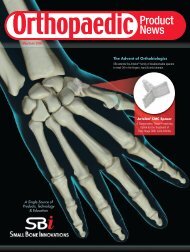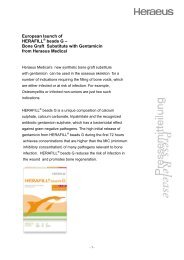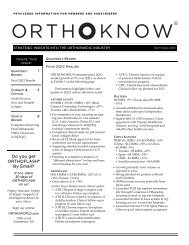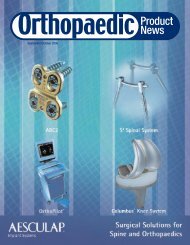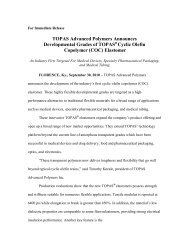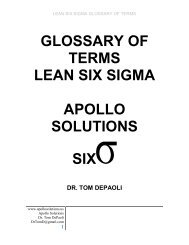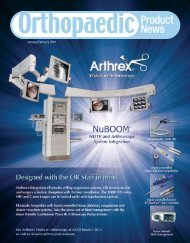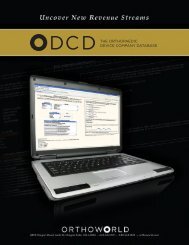Hip & Knee Surgery - Orthoworld
Hip & Knee Surgery - Orthoworld
Hip & Knee Surgery - Orthoworld
Create successful ePaper yourself
Turn your PDF publications into a flip-book with our unique Google optimized e-Paper software.
GIVING BACKSIGN Starts Three Beta Sites onEast Africa TripAuthor: Lewis G. Zirkle, Jr., M.D.I travelled with Jeanne Dillner, the Chief Executive Officer of theSurgical Implant Generation Network or SIGN, to East Africa toestablish three new beta sites for the device we have been developingto stabilize hip fractures. SIGN engineers have worked on thedesign and performed bench testing over the course of three years.We increased our efforts after seeing 20 patients in traction in onehospital in Afghanistan. We were told that after three weeks theywould be placed in body casts and sent home. Electricity was on foronly three hours per day, and the temperature was freezing.The three new beta sites for hip fixation trials in East Africaincluded Muhimbili Orthopaedic Institute in Dar es Salaam,Tanzania; Mulago Hospital in Kampala, Uganda; and MOI Hospitalin Eldoret, Kenya. These proved to be excellent choices, as each ofthem had scheduled four hip cases that could be operated on withthe SIGN <strong>Hip</strong> Construct (SHC). The most challenging fractures hadoccurred three months prior. The surgeons also had collectedunusual long bone fractures in which the SIGN nail could be usedin unique ways. As with the SIGN IM Nail System, the SHC isimplanted without a C-arm, which means surgeons use their tactilesenses to place the implants. The SIGN surgeons at all three sitesperformed the surgery very well. We all learned from the surgicalchallenges as well as from each other. A three-month delay in treatmentis acceptable in treating long bone fractures, but not for hipcases, because the hip fractures occur in softer bone. When onetakes out the healing callus, only the shell of cortical bone is left.Another patient had a fractured femoral shaft as well as a hip fracture,so we had to allow for the rotation of the nail to accommodatethe interlocking screws in both hip and shaft fractures.During each visit, I emphasize two or three new ideas for implementationby SIGN surgeons. One teaching point which I practice isto think about each surgery the night before. Like the quarterbackwho visualizes each play and anticipates the potential reaction by theopposing team, I teach the surgeons to think about each situation theymay encounter and how to react to get the best result for the patient.One of the challenging long bone fractures presented us withmany teaching points. Seventy-year-old Badasa Muhula had a fracturedfemur and an arthritic knee which deviated 45° into valgus.She told us that her worst pain was in her knee and she would likethis to be corrected at the same time. She could not afford to buy aknee replacement device, but the SIGN system was available andfree to her. Dr. Lectary Lelei and I discussed this case with the othersurgeons the day before and developed a rough game plan, whichwe implemented the next day. We first placed one nail down thefemur to stabilize the fracture. We removed wedges from the tibiaand femur to straighten the knee, and then made a slot in the femurand placed the nail across the knee joint into the tibia. We placedinterlocking screws through this nail on both sides of the knee joint.When she awakened and saw her straight knee, she was veryhappy. Badasa was recuperating on the Sylvester Neal Ward.Sylvester Neal is the vice president of Kiwanis International, whichhas been very helpful in raising funds. This program has beensponsored by Kiwanis.We were rewarded on this trip with many challenging surgeries.Another reward occurred when I heard the surgeons talking aboutthe thinking surgeon at dinner. I had emphasized this because ourSHC has many components and variables which can be used in differentways. It is not a cookbook operation, in which the surgeonfollows specific steps dictated by the implant company. Each step ofthe way, the surgeon must make a decision and think of its consequences.The school system in East Africa is one based on rotememory. The thinking surgeon is a departure from this. This changein attitude provided me with great pleasure and satisfaction.SIGN has many facets. Attendees at the annual SIGN conferenceoften remark about the SIGN culture. The human element is farmore important than the implants. Having a high regard for thepatient makes the surgeon strive to do his best. This means thatmost waking hours are devoted to thinking about how to treatpatients optimally. Each patient comes in with a different problemfrom the last or from any other patient. They must be treated asindividuals yet follow principles which have been known foryears. That's the art of medicine.Lewis G. Zirkle Jr. M.D. is a board certified orthopedic surgeon in privatepractice in Richland Washington. He graduated from Davidson Collegeand Duke University Medical Center. He was selected to continue atDuke University Medical Center for surgical and orthopedic surgerytraining but was drafted into the U.S. Army and sent to Vietnam. Hecontinued his training in the Army.Experience in the Army convinced him that many people are caught inthe middle of a conflict or an accident for which they have no control. Theyare injured and must be cared for. This may apply to civilians caught inthe middle of a conflict, disaster victims and most people caught in a risingepidemic of injuries in the world.He has traveled extensively in developing countries to teach orthopedicsurgery. In 1994 he realized that training is not sustainable unlesssurgical implants to stabilize fractures are donated along with teachingabout fracture care. SIGN was formed on that premise.Since SIGN was founded, he has spent increasing amounts of timeengaged in development of new surgical implants which can be used indeveloping countries, developing curriculum applicable to the surgeons,and traveling to teach surgery and modern orthopaedic care. He is passionateabout SIGN’S Mission and vision. He can be reached atsigncom@sign-post.org.58 ORTHOPAEDIC PRODUCT NEWS • November/December 2009



